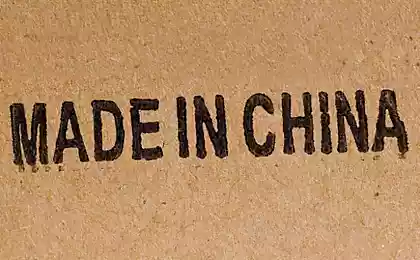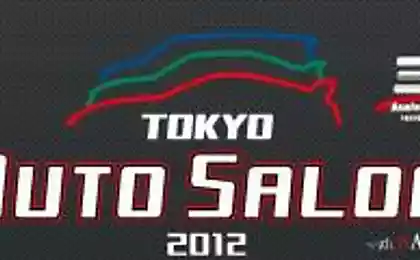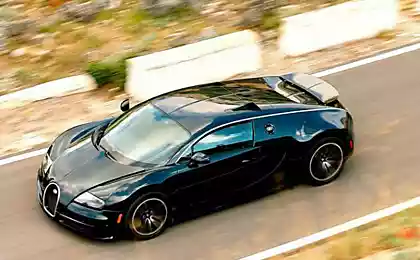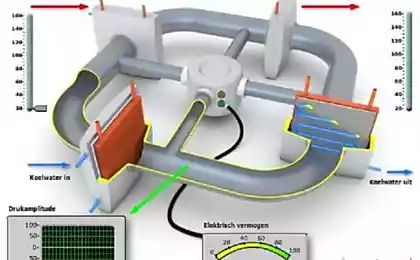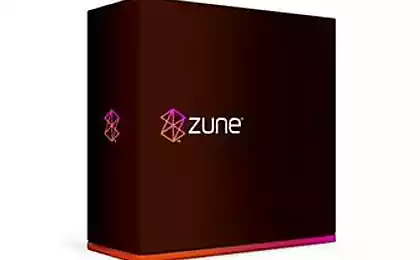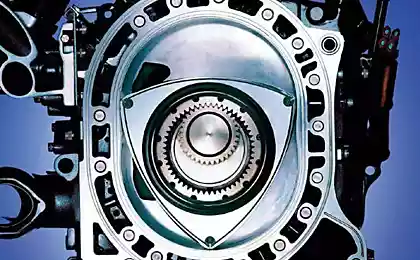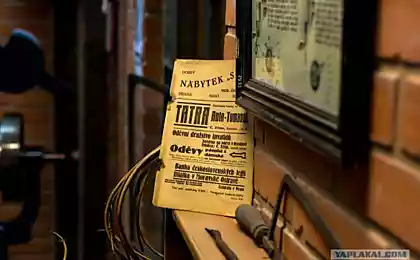905
Evolution MP3 players
15 photo + letter
Write to memory MP3-player several gigabytes of your favorite music and put it in his pocket compact easy to the road instead of polyphonic composition of passenger voices, the noise of the street or the subway to have a nice background sound. A great opportunity, but familiar, and even sometimes lack. But recently I had to find a desired tone is not a barely noticeable touch of a finger with the touch screen flashed upon him the names and other attributes of the files, and rewind the tape, and then clicking the buttons in an attempt to get "to the point" - at the beginning of the song. CD-players, without a doubt, improve the situation of mobile music, but their size was not the biggest advantage. Flash memory (and miniature HDD) has become a true breakthrough, consider that perhaps was not immediately and not to all. Just over 10 years ago, "iPods" and no dream: their predecessors were big, expensive and running on battery power for a short time.
The advent of the MP3 format has brought the possibility of collecting hundreds and thousands of songs in digital format. Initially, this could only be satisfied users of personal computers, and the next logical step was the transfer of format support in devices like Sony Walkman. In 1998, Elger Labs MPMAN F10 unveiled a $ 250 with a storage capacity of 32 MB. Soon followed the Diamond Rio PMP300 with a similar capacity. PMP300 further strengthened the position of MP3, what attracted the attention of the American record industry, represented by Recording Industry Association of America (RIAA). The organization started the prosecution of subsidiary Diamond - RioPort, because she feared the spread of piracy, when thousands of consumers will be able to transfer tracks from the new titles in digital format. RIAA lost. In 1999, there was Napster, added the holders even more headaches.

Needless to say that the biggest problem of the first models of MP3-players was the amount of memory. Ceiling - 64 Mb, which was barely enough to compositions from one CD. In 2000, 1 MB of flash memory cost $ 03.04 (about $ 3,500 for 1 GB) - clearly can not afford the average consumer, and the chips were much less spacious than it is today. Device Remote Solutions Personal Jukebox made a small revolution in 1999, as was equipped with 4, 8 GB support. Acceptable cost has been achieved using a hard drive used in notebooks. But even such a decision from today's point of view it seems unviable: Personal Jukebox was heavy and expensive - $ 800.

In 2000, Creative released the Nomad Jukebox $ 500 with 6 GB of memory. The device in terms of size did not have advantage over CD-player, but the only alternative is a 2-GB i2Go EGo for $ 2,000. In the same year she appeared in the sale of MC-P10 from Sony with 64 MB of memory, which can be purchased for $ 300. Without a fly in the ointment there has not been - only play files encoded in a proprietary format ATRAC.
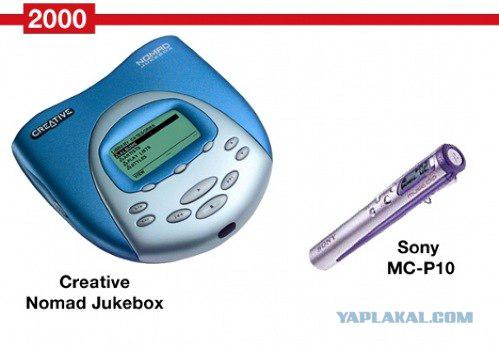
While other manufacturers have achieved acceptable performance technologies of flash memory and HDD, Iomega has decided to take a risk, revealing the world of 40-MB HipZip for $ 300. In it use the same disk as in the media Iomega Zip, costs $ 10.

In 2001, Intel made another significant step in this segment, releasing 128 MB Pocket Concert. The player cost $ 300 and was popular, but later in the same year, chip maker closed its home electronics division, stopping the production of the device. At the same time, Apple introduced the first generation iPod to the 1, 8 & quot; Toshiba's hard disk capacity of 5GB and a large monochrome display. The product was sold for $ 400 and comes with software iTunes, compatible only with a Mac.
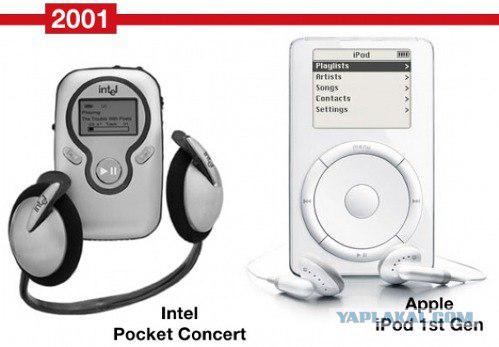
In 2002, the parting of the ways in the classroom MP3-players showed more clearly. The representative of one "branch" was the Archos Jukebox Multimedia, existed in two versions: 10 GB and 20 GB. For younger model asked for $ 400. It was the first such device, the user is able to view the screen of individual images and video. On the other hand, Creative MuVo players prepared line with the volume of flash memory of 64 MB and 128 MB. Working up to 12 hours of battery life on a single AAA battery, this product has been accepted by the market is very positive.
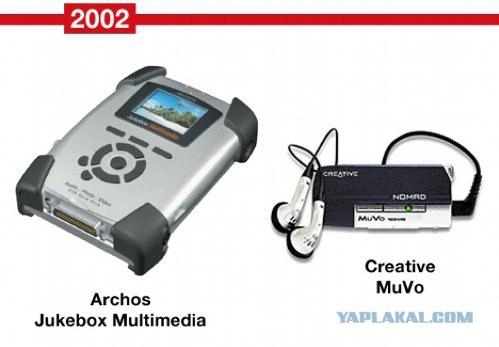
In 2003, with the design of experiments players continued. Rio Karma had a 20 GB disk and won fans with music playback without interruption. A Sony NW-MS70D was one of the most compact in its time. In addition to its 256 MB you can take advantage of 128-MB memory card. One battery charge enough for 40 hours, and the unit cost of $ 300 - the same as released in the same year, a new iPod with a 15 GB HDD.

Apple in 2003 introduced a significant addition to the iPod - the service iTunes Music Store, which was a feature of the digital protection to sell songs. The player models, the third generation appeared above the wheel button control device is equipped with a USB interface and a battery with a battery life up to 8 hours.
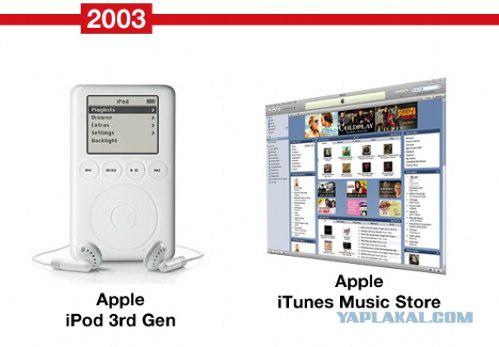
In 2004, the color displays in MP3-players is no surprise. Equipped with them, and not cheap ($ 500) Creative Zen Media Center with a 40-GB hard drive and 3, 8 & quot; screen running Windows Mobile. iRiver H300 with integrated FM-radio has a smaller size and has the ability to play videos. The device is sold with a 20-GB or 40-GB HDD. This year there was also an iPod with a color display and offers 60 GB of storage space for $ 350.
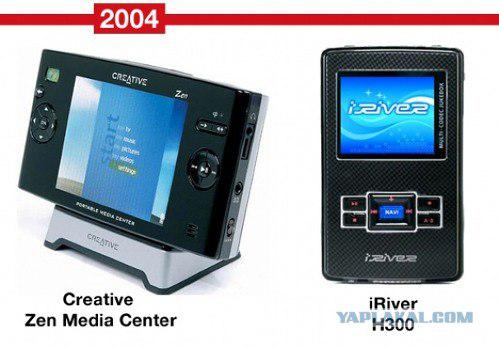
If the player is equipped with hard drives in 2005, the availability of color screen was a standard, the device's flash memory has other advantages - relative cheapness and compactness. iPod Shuffle worth $ 100 for the 512 MB model, but twice as much capacity costs $ 150. Designs from Dell DJ Ditty may not stand the same elegance, but a 512-MB device for the same $ 100 offered to FM-radio and a small display. However, sales did not reach the planned level, and in 2006 the release of the product has been discontinued.

2006 remembered the advent of Microsoft's Zune 30 GB of memory, radio, 3 & quot; color LCD screen and a price of $ 200. It was planned that the new product will be a comprehensive solution with access to the service Zune Store, where for $ 15 a month, you can download any number of musical content. Come out of the fight with Napster in the media industry as well as the much-changed offered on a subscription music service Zune and iPod, but the popularity of such services did not.
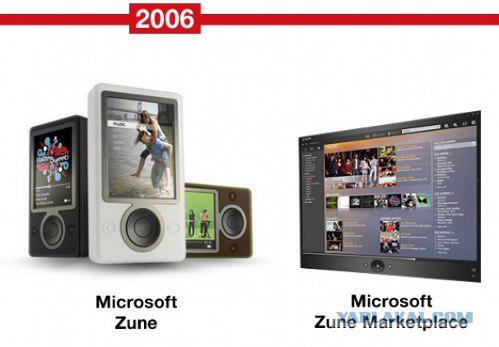
Distribution of players with touchscreens began in 2007. Thus, iPod Touch first generation had a 16 GB memory and 3, 5 & quot; display, and the cost was $ 400. Similar capacity - at the YP-P2 Samsung's interface Bluetooth. Wireless connectivity allows for connection to the phone to make and receive calls on your device.
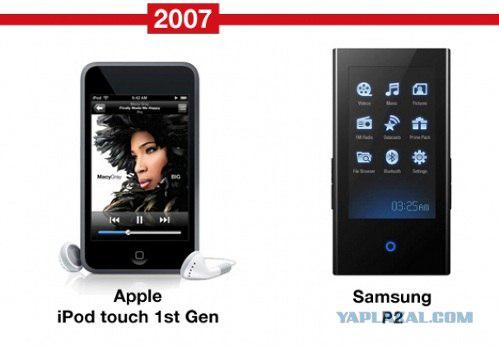
In the third-generation iPod Nano, you can view images, videos and use depending on the model 4 GB or 8 GB of memory. The competition this player Microsoft had intended to make the updated line of Zune models 4 and 8. Both touch control devices, and compositions and images freely copied.
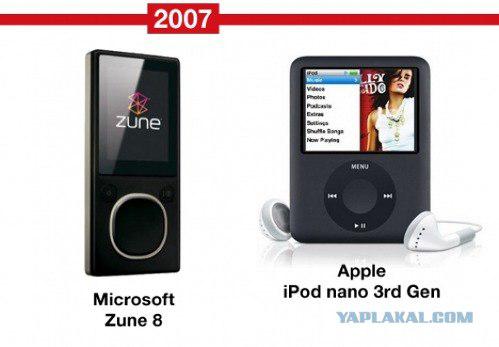
2008 specific steps in improving the players do not remember. Typical models - Sansa Fuze with memory capacity up to 8GB and connector microSD (under 2-GB model cost $ 75), a series of Sony E-Series Walkman in versions with 4 GB of memory for $ 70 and 8GB for $ 120.
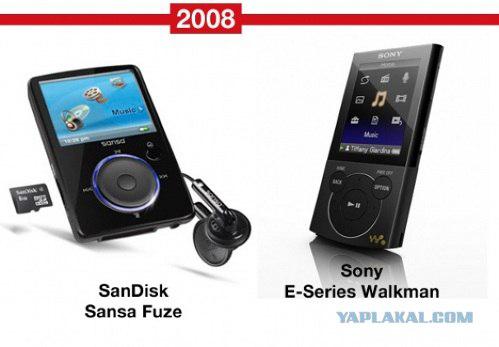
Today, the line between the MP3-player and multi-functional mobile devices gradually erased; among the possibilities - support S-Video, Wi-Fi, browser, video playback. Introduced in September Zune HD comes with OLED-display, memory capacity up to 32GB, has Wi-Fi and radio. Microsoft offers to buy the device for $ 220.
hence
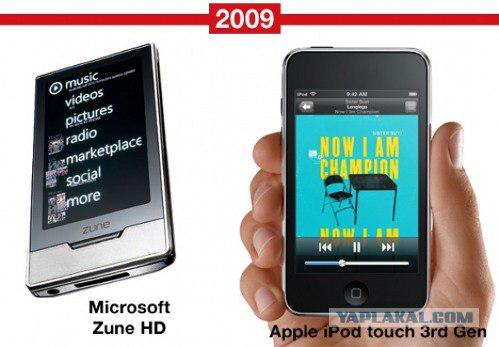
Source:
Write to memory MP3-player several gigabytes of your favorite music and put it in his pocket compact easy to the road instead of polyphonic composition of passenger voices, the noise of the street or the subway to have a nice background sound. A great opportunity, but familiar, and even sometimes lack. But recently I had to find a desired tone is not a barely noticeable touch of a finger with the touch screen flashed upon him the names and other attributes of the files, and rewind the tape, and then clicking the buttons in an attempt to get "to the point" - at the beginning of the song. CD-players, without a doubt, improve the situation of mobile music, but their size was not the biggest advantage. Flash memory (and miniature HDD) has become a true breakthrough, consider that perhaps was not immediately and not to all. Just over 10 years ago, "iPods" and no dream: their predecessors were big, expensive and running on battery power for a short time.
The advent of the MP3 format has brought the possibility of collecting hundreds and thousands of songs in digital format. Initially, this could only be satisfied users of personal computers, and the next logical step was the transfer of format support in devices like Sony Walkman. In 1998, Elger Labs MPMAN F10 unveiled a $ 250 with a storage capacity of 32 MB. Soon followed the Diamond Rio PMP300 with a similar capacity. PMP300 further strengthened the position of MP3, what attracted the attention of the American record industry, represented by Recording Industry Association of America (RIAA). The organization started the prosecution of subsidiary Diamond - RioPort, because she feared the spread of piracy, when thousands of consumers will be able to transfer tracks from the new titles in digital format. RIAA lost. In 1999, there was Napster, added the holders even more headaches.

Needless to say that the biggest problem of the first models of MP3-players was the amount of memory. Ceiling - 64 Mb, which was barely enough to compositions from one CD. In 2000, 1 MB of flash memory cost $ 03.04 (about $ 3,500 for 1 GB) - clearly can not afford the average consumer, and the chips were much less spacious than it is today. Device Remote Solutions Personal Jukebox made a small revolution in 1999, as was equipped with 4, 8 GB support. Acceptable cost has been achieved using a hard drive used in notebooks. But even such a decision from today's point of view it seems unviable: Personal Jukebox was heavy and expensive - $ 800.

In 2000, Creative released the Nomad Jukebox $ 500 with 6 GB of memory. The device in terms of size did not have advantage over CD-player, but the only alternative is a 2-GB i2Go EGo for $ 2,000. In the same year she appeared in the sale of MC-P10 from Sony with 64 MB of memory, which can be purchased for $ 300. Without a fly in the ointment there has not been - only play files encoded in a proprietary format ATRAC.

While other manufacturers have achieved acceptable performance technologies of flash memory and HDD, Iomega has decided to take a risk, revealing the world of 40-MB HipZip for $ 300. In it use the same disk as in the media Iomega Zip, costs $ 10.

In 2001, Intel made another significant step in this segment, releasing 128 MB Pocket Concert. The player cost $ 300 and was popular, but later in the same year, chip maker closed its home electronics division, stopping the production of the device. At the same time, Apple introduced the first generation iPod to the 1, 8 & quot; Toshiba's hard disk capacity of 5GB and a large monochrome display. The product was sold for $ 400 and comes with software iTunes, compatible only with a Mac.

In 2002, the parting of the ways in the classroom MP3-players showed more clearly. The representative of one "branch" was the Archos Jukebox Multimedia, existed in two versions: 10 GB and 20 GB. For younger model asked for $ 400. It was the first such device, the user is able to view the screen of individual images and video. On the other hand, Creative MuVo players prepared line with the volume of flash memory of 64 MB and 128 MB. Working up to 12 hours of battery life on a single AAA battery, this product has been accepted by the market is very positive.

In 2003, with the design of experiments players continued. Rio Karma had a 20 GB disk and won fans with music playback without interruption. A Sony NW-MS70D was one of the most compact in its time. In addition to its 256 MB you can take advantage of 128-MB memory card. One battery charge enough for 40 hours, and the unit cost of $ 300 - the same as released in the same year, a new iPod with a 15 GB HDD.

Apple in 2003 introduced a significant addition to the iPod - the service iTunes Music Store, which was a feature of the digital protection to sell songs. The player models, the third generation appeared above the wheel button control device is equipped with a USB interface and a battery with a battery life up to 8 hours.

In 2004, the color displays in MP3-players is no surprise. Equipped with them, and not cheap ($ 500) Creative Zen Media Center with a 40-GB hard drive and 3, 8 & quot; screen running Windows Mobile. iRiver H300 with integrated FM-radio has a smaller size and has the ability to play videos. The device is sold with a 20-GB or 40-GB HDD. This year there was also an iPod with a color display and offers 60 GB of storage space for $ 350.

If the player is equipped with hard drives in 2005, the availability of color screen was a standard, the device's flash memory has other advantages - relative cheapness and compactness. iPod Shuffle worth $ 100 for the 512 MB model, but twice as much capacity costs $ 150. Designs from Dell DJ Ditty may not stand the same elegance, but a 512-MB device for the same $ 100 offered to FM-radio and a small display. However, sales did not reach the planned level, and in 2006 the release of the product has been discontinued.

2006 remembered the advent of Microsoft's Zune 30 GB of memory, radio, 3 & quot; color LCD screen and a price of $ 200. It was planned that the new product will be a comprehensive solution with access to the service Zune Store, where for $ 15 a month, you can download any number of musical content. Come out of the fight with Napster in the media industry as well as the much-changed offered on a subscription music service Zune and iPod, but the popularity of such services did not.

Distribution of players with touchscreens began in 2007. Thus, iPod Touch first generation had a 16 GB memory and 3, 5 & quot; display, and the cost was $ 400. Similar capacity - at the YP-P2 Samsung's interface Bluetooth. Wireless connectivity allows for connection to the phone to make and receive calls on your device.

In the third-generation iPod Nano, you can view images, videos and use depending on the model 4 GB or 8 GB of memory. The competition this player Microsoft had intended to make the updated line of Zune models 4 and 8. Both touch control devices, and compositions and images freely copied.

2008 specific steps in improving the players do not remember. Typical models - Sansa Fuze with memory capacity up to 8GB and connector microSD (under 2-GB model cost $ 75), a series of Sony E-Series Walkman in versions with 4 GB of memory for $ 70 and 8GB for $ 120.

Today, the line between the MP3-player and multi-functional mobile devices gradually erased; among the possibilities - support S-Video, Wi-Fi, browser, video playback. Introduced in September Zune HD comes with OLED-display, memory capacity up to 32GB, has Wi-Fi and radio. Microsoft offers to buy the device for $ 220.
hence

Source:




